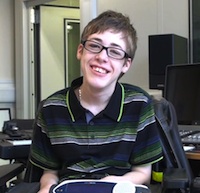 My
name is Chris Jacquin and I am a 17-year-old music student at George Watson’s
College, Edinburgh. I started using Brainfingers for performing music when I was
13 years old. I use Brainfingers to complete the performing module of my music
courses, which has therefore enabled me to pass two music exams. I am now using
Brainfingers to perform as part of an ensemble called Technophonia for the 2012
Cultural Olympiad and will be performing in concert halls in Edinburgh, Glasgow
and London. Brainfingers has let me perform music to the best of ability. To see
more about my work with Brainfingers go to:
My
name is Chris Jacquin and I am a 17-year-old music student at George Watson’s
College, Edinburgh. I started using Brainfingers for performing music when I was
13 years old. I use Brainfingers to complete the performing module of my music
courses, which has therefore enabled me to pass two music exams. I am now using
Brainfingers to perform as part of an ensemble called Technophonia for the 2012
Cultural Olympiad and will be performing in concert halls in Edinburgh, Glasgow
and London. Brainfingers has let me perform music to the best of ability. To see
more about my work with Brainfingers go to:
http://www.bbc.co.uk/news/uk-scotland-edinburgh-east-fife-17583426
There is a video of me on YouTube as well, your browser may not open the following link, if not please select open in new page if given option or right click on the link and select open in new page etc..
http://www.youtube.com/watch?v=8Q2j2Da-G2c
Chris Jacquin
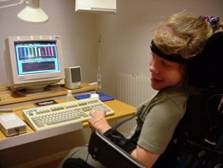 Therese,
with the help of Stefan Dellenborg and others, has achieved successful communication
using Brainfingers. Therese is 24 years old and has severe Cerebral Palsy. Prior
to using Brainfingers she could not use any computer access device for communication.
Initial work with Brainfingers indicated that she could not successfully control
the device with forehead muscle activation. Control was next attempted with various
brainwave signals. After a month of practice with Brainfingers she could control
a brainwave frequency band centered at 21.25 Hz with consistency.
Therese,
with the help of Stefan Dellenborg and others, has achieved successful communication
using Brainfingers. Therese is 24 years old and has severe Cerebral Palsy. Prior
to using Brainfingers she could not use any computer access device for communication.
Initial work with Brainfingers indicated that she could not successfully control
the device with forehead muscle activation. Control was next attempted with various
brainwave signals. After a month of practice with Brainfingers she could control
a brainwave frequency band centered at 21.25 Hz with consistency.
She now uses an on-screen keyboard called Clicker 4. The Clicker 4 software is setup to run in a scan and click mode. The software displays grids with symbols shown in the grids. The symbols are part of what is called “bliss symbols”. The software scans through the grids and Therese increases the brain frequency amplitude at the appropriate time to cause the amplitude to cross a threshold, which results in sending a click signal to Clicker 4. Today Therese can type text and express what she wants and what she feels. For more information and photos of Therese.
Letter from Simone Vecchia of Italy, Helped by Nicola Liboni Cooperativa Sim-Patia, Italy +39 (0)31 806030, http://www.sim-patia.it
My name is Simone and I am 31 years old. When I was born I had a genetic disorder became quadriplegic and had a tracheostomy. 8 years ago I started using Brainfingers, which allows me to use the PC almost completely independently. Today a computer is used by people as a mean for work, knowledge, entertainment, study, etc.. To me it is something more. It's my window on the world outside: the window that, before having Brainfingers, I was forced to open by a person who did it for me, as I didn't use my hands. This was very limiting to me. Now, with a headband equipped with sensors, placed on the front, I can perform the functions of the mouse: I am using a PC by myself! I can deepen my interests, surf the internet, communicate and interact with other people, that is, do a summary of all the things people "able-bodied" do and this, you understand, is so wonderful! Brainfingers, as I explained earlier, is a headband with internal sensors: a device extremely flexible, which is well suited for all types of disabilities. Easy to use, gives independence to the person. The use of the PC also allowed me to keep me informed and to look at the world from a independent perspective. I hope that in the future, in Italy (my country), we'll speak more of this aid that can help persons with disabilities. I hope that in the future Brainfingers may be used widespread and let people the opportunity to talk. I therefore thank Andrew, the inventor of Brainfingers, and SIM-PATIA for having introduced me to this precious instrument.
Simone Vecchia
Christi was in a single car roll over accident on her way home from her freshman year of college. The accident resulted in a torn mesentery artery, loss of ¾ of her blood, and severe shearing brain injury. She was in a coma for 3 months; her survival chance was 1%. For the past 13 years we have had her at home. Christi is mute but has a very reliable eye blink to respond to questions. She also will vocalize if we misread her. We have tried a variety of communication systems but all have frustrated her and us as they rely primarily on motor processing.
Out of frustration I (the mother) began looking on the Internet and found “brainfingers”. In the past year and a half we see her excited and willing to do brainfingers on a consistent basis. Christi is getting more and more precise in her motor movements with her facial muscles, as well as with her eye gazes. We call Brainfingers her brain exercises and it is a vital component to her continued recovery. Her goal with “Brainfingers” is not necessarily a way to communicate with others but a way to have some control and exercise parts of her brain that have not had that opportunity since the accident.
The following success story is written about special education teacher Danise M. Marler, M.A., Sp. Ed.. and her students. The story is taken from the Los Angeles County Office of Education (LACOE) Newsletter on Educational Programs. Dani's excellent work also earned her a Master's Degree from CSUN. Part of her work for the degree involved a Case Study using Brainfingers with her students.
Since childhood, special education teacher Dani M. Marler has wanted to be the next Annie Sullivan, the “miracle worker” who opened up the world for Helen Keller. That day may have come. Marler is working little miracles for her students with profound multiple disabilities at LACOE’s Lincoln School in San Gabriel thanks to a hands-free computer controller. Its use is opening up a new world for students who previously had no meaningful access to technology for communication, learning and fun. “I’ve always believed my students can do so much more than they’ve been assessed” Marler says. Most of her middle school-age students are considered to function at a cognitive level of less than 18 months of age. They cannot walk or talk. “These students haven’t been able to use any existing technology to access computers, including a single switch device no matter where it is located on or around their bodies” she says.
Always on the lookout for new technologies that would aid her students Marler discovered "Brainfingers”. Convinced this could make a difference for her students, Marler obtained a grant to bring the technology into her classroom. The remarkable results are now the subject of her master’s thesis. Marler studied the progress over eight weeks of four students ranging in age from 9 to 19 who used Brainfingers one hour a day, twice a week. During this time she observed: Increase attention span – from 30 seconds to more than 30 minutes Student’s successful use of toddler reading programs and video games Improved social and emotional outcomes, including increased desire to learn Recently in Marler’s classroom, student Briana is engrossed in a game of video “Pong” smiling when she scores points. Not long ago, the 19 year-old spent most of her day impassive in her wheelchair. Briana’s mother, Lorraine says the change in her daughter since using Brainfingers is amazing. “She’s more focused, her entire demeanor has changed. She’s alert and her eyes respond when she looks at things” Marler says, “These students now have something they’ve never had before, and this is just the start – who knows where they can go”
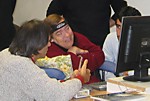 The
following letter was written by Carla using her Brainfingers system. Carla lives
in Italy. We recently visited with Carla and our distributor in Northern Italy
Cooperative Sociale SIM-PATIA. Carla wrote the email in Italian and Nicola Libonie
was good enough to include a translation.
The
following letter was written by Carla using her Brainfingers system. Carla lives
in Italy. We recently visited with Carla and our distributor in Northern Italy
Cooperative Sociale SIM-PATIA. Carla wrote the email in Italian and Nicola Libonie
was good enough to include a translation.
CARI ANDREW E PATRICIA
SONO MOLTO CONTENTA DELLA VOSTRA VISITA. IL CYBERLINK E' DI UN'UTILITA' ESTREMA PER I DISABILI, RENDENDOLI UN PO' PIU' INDIPENDENTI NELL'USO DELLA SCRITTURA AL COMPUTER. PER ESEMPIO IO NON AVREI MAI POTUTO SCRIVERE UNA LETTERA COME STO FACENDO ORA. MI SCUSO PER IL MIO RITARDO VERGOGNOSO, GRAZIE E SPERO CHE POSSIATE VENIRE ANCORA PRESTO: MI PIACEREBBE ANCHE VENIRE A VEDERE IL LUOGO DOVE ANDREW ELABORA LE SUE BELLE INVENZIONI. GRAZIE ANCORA ED UN ABBRACCIO RICONOSCENTE DALLA VOSTRA CARLA.
This italian email has fully been written by Carla! I only traslated her text :-( Nicola Libonie, Sim Patia
DEAR ANDREW AND PATRICIA,
I'M VERY HAPPY FOR YOUR VISIT HERE. CYBERLINK IS VERY USEFUL FOR DISABLED PEOPLE, IT MAKES US MORE INDIPENDENT IN WRITING WITH THE COMPUTER. FOR EXAMPLE I COULDN'T EVER HAVE WRITTEN A LETTER LIKE I'M DOING NOW. SORRY FOR MY LATE, THANKS A LOT AND I HOPE YOU'LL COME HERE AGAIN SOON: I'D ALSO LIKE TO VISIT YOU TO SEE THE PLACE WHERE ANDREW GIVES LIFE TO HIS GOOD IDEAS. THANKS AGAIN AND A BIG HUG FORM YOUR CARLA.
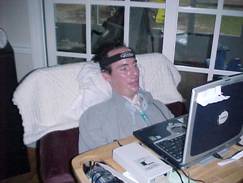 “My
name is Alston Daniel; I have had ALS for thirteen years since I was twenty-six.
ALS was constantly robbing me control of my muscles. As this was happening I was
constantly trying to adapt to an ever-changing life style. I found myself becoming
more dependent on my computer for daily activities. It was my most valuable asset.
As time past, it was becoming ever so more difficult and exhausting to operate.
Little did I know I was beginning a long journey of computer access devices, which
would prove to be of short-term use and position sensitive; i.e. one must be directly
in front of device. If body is jarred or moved accuracy of device is compromised.
“My
name is Alston Daniel; I have had ALS for thirteen years since I was twenty-six.
ALS was constantly robbing me control of my muscles. As this was happening I was
constantly trying to adapt to an ever-changing life style. I found myself becoming
more dependent on my computer for daily activities. It was my most valuable asset.
As time past, it was becoming ever so more difficult and exhausting to operate.
Little did I know I was beginning a long journey of computer access devices, which
would prove to be of short-term use and position sensitive; i.e. one must be directly
in front of device. If body is jarred or moved accuracy of device is compromised.
In January 2002, I went into respiratory failure; an emergency tracheostomy was performed. From that point on I was completely trapped in my body. Unable to move, now unable to communicate, At this point I had no interest in living this way. When I returned home from the hospital I frantically searched for a device which would allow me to access my computer with little or no movement. Using my communication board, I told my wife, I found it. She looked at Brainfingers with skepticism, reminding me of previous computer access devices I have used. When I received Brainfingers and started using it, I told her there was no comparisons of Brainfingers to any other computer access devices on the market. One would think Brainfingers came from a Hollywood movie, but it did not. Team BAT, thank you for giving me so much back which ALS has taken from me. I now can use a computer like any other able person. I am now communicating with family and friends, taking online classes, doing my banking and much-much more, all fast and efficient. Best of all, I can use my computer in any position, while having PT, in the van etc. Brainfingers is fantastic!
Oh, my nurses said thank you; they do not have to use communication board any more.
Again,
thank you,
Alston”
I am a person with ALS also known as Lou Gehrig’s disease. I was diagnosed in 1991 and I had to go on a ventilator in late 1995. I have been under the care of Dr. Joshua Benditt since 1994. Today I am completely paralyzed from head to toe except for my eyes and jaw. I need 24 hour skilled nursing care. I have been lucky to live at home with the full support of my wife Urmi, daughter Devki, and son Vishal. ALS progressively paralyzes all the voluntary muscles.
The most crucially important thing in having an acceptable quality of life for me was the ability to access and control a computer. This would give me a way to communicate, be productive and access the world. When I lost the use of my hands, I used the mouse with my foot. As the disease progressed, I had to resort to more and more sensitive switches which I could click with a minute movement of the head. Finally, at the end of 2000, I had lost all ability to activate any physical switches.
That’s when I discovered the quality-of-life saving Brainfingers! Brainfingers, the brain actuated computer interface. It's quite amazing! At it's most elementary level, a headband picks up voltage created by muscle movements such as jaw close and eyebrow lift to cause a click or switch close action. At it's most sophisticated it picks up certain brain waves to click, point and control a mouse.
I am currently using Brainfingers to operate my Wivik on screen keyboard. Works great! Andrew Junker has been very helpful in getting me going in just one day. Besides the obvious breakthrough technology, the software is very thoughtfully designed and easy to use for the profoundly disabled. It can be fine tuned in several ways to pick up the faintest signal.
I use Brainfingers to activate as on-screen keyboard, Wivik, which allows me to speak, write and work with Windows programs. I manage the family finances using Microsoft Money, communicate with family in India using Microsoft Outlook, research anything and everything using Internet Explorer. These types of programs have been a great contributor to my quality of life and also have made me more than a little bit productive. I am currently working on several projects. I am helping an Indian firm develop special communications software for Dr. Stephen Hawking. I am beta testing next generation Wivik software from the Bloorview McMillian Children’s Center in Ontario .
Brainfingers has made my life fun again!
Sunil
Seattle,
WA
Ed. Note: This user has Repetitive Strain Injury (RSI). She is a computer program that is now able to work 8 hours and not be hampered by RSI because she can achieve computer control by combining Brainfingers with Naturally Speaking voice software.
“Dear
BAT:
Just a very quick note to thank you again for the long-gesture toggle
between full mouse and multiple clicks launch. I am using it constantly and am
extremely thankful every time I use it! It really is changing my work pattern
and making it much easier to read and concentrate on what I'm trying to do. It
is also very useful for stabilizing the mouse even if I'm not particularly interested
in the exact location of it.
I tried to achieve the same thing with voice
macros, but the result was not nearly as good because during the elapsed time
the mouse moved so I could not pinpoint a target and leave the mouse position
on it. This is nearly instantaneous and the jaw gestures are very subtle and not
uncomfortable so they did not discourage very frequent transitions between modes.
I really hadn't conceived of such a frequent switching of modes and its advantages
until the future actually appeared.
The other thing I have discovered is that
the Naturally Speaking feature that used to drive me nuts which is that it actually
gets focus to a control when you click with your voice, works wonderfully for
positioning the mouse which I then freeze at that location with Brainfingers allowing
me to repeat the action (for example when ignoring changes using grammar check
in Microsoft Word).
Anyway, I am still getting a little surge of excitement
every time it works although I'm sure eventually I will take for granted.
Thanks again, Deborah”
Ed. Note: This user had a spinal cord injury and had no means of computer access until they found Brainfingers.
“Dear
BAT:
Christer, a Norwegian in his early twenties, had a serious accident in
the summer of ’98. After critical care he was transferred to the Spinal
Cord Injury Unit at Haukeland University Hospital for rehabilitation. He suffered
a spinal cord injury at the C1 level, and is paralyzed from his head down. He
is not able to speak, and he is using a ventilator. His vision is reduced, and
initially he frequently had to cover up one eye due to infection. In addition
the injury caused a cognitive disorder, and Christer has problems with his memory.
Initially, the only way to communicate with Christer was by asking yes/no questions,
and he would answer by moving his eyes.
One of our challenges was to find
a way for him to control a computer. This would not only be important for communication,
but would also give him the possibility to control his environment (stereo, TV,
VCR). First we tried a muscle-sensor placed between his eyebrows. Raising his
eyebrows would then trigger the sensor and give a signal to the computer.
This worked, but it had some major drawbacks. The sensor had to be placed very
accurately in the correct position. The gain of the sensor had to be adjusted
before every session, and it often had to be readjusted during the session. After
a few minutes of use, his muscles started to tire. Small muscle-spasms would then
develop, and these spasms would trigger the sensor and give false signals. As
a total, this solution did not function. It was too difficult to set-up, and even
when set-up properly it was not reliable enough. At this time we were constantly
searching for better switches. We tried a few other arrangements, but nothing
worked well enough.
After about a year, we ran across Brainfingers. Even
though we thought Brainfingers primarily was intended for more complex use then
what Christer was ready for, we soon realized Brainfingers great potential as
a single switch. Here we had a sensor that was truly flexible. We could customize
filters, threshold-values and more for our requirements, and the headband was
easy to put on. We learned that the system did not require any further calibration
prior to each session. And best of all, the system was very accurate. After an
initial trial-period, we had a few suggestions for improvements that would benefit
our user greatly. We contacted BAT, and they were willing to update the software
and incorporate our suggestions.
The result is great! Christer is now using
Brainfingers on a daily basis. Primarily it is used for communication, together
with an on-screen keyboard (Flexisoft) and scan. Letters are then sent to MS-word,
were he may print out the result when finished. The computer is also used for
educational purposes, and he has weekly sessions with his teacher. In addition,
he can control the CD player, play mp3 music-files, control a TV-tuner and look
through pictures in his own digital photo-album. When we started using Brainfingers,
we didn’t know what to expect. By this time Christer had some bad experience,
and he did not enjoy using the computer at all. With Brainfingers, we initially
focused on confidence building. Slowly, Christer started enjoying working with
the computer again. He learned new tasks much quicker than we expected, and he
is now performing way beyond our wildest expectations.
Best
regards,
Bent Hamnes
Haukeland University Hospital
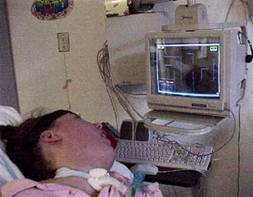 "Carol,"
(not her actual name) is an18-year-old girl, and a student at Success for Kids
School, Loma Linda CA. Struck by a motor vehicle at the age of 11, she suffered
a traumatic brain injury, cerebral palsy, spastic quadriplegia and scoliosis.
She was diagnosed in a Persistive Vegetative State (PVS) following emergency treatment
at the time of the accident. Before training on Brainfingers she could track visually,
use eye-blink to indicate yes/no and use switches with physical prompting but
displayed no voluntary motor control.
"Carol,"
(not her actual name) is an18-year-old girl, and a student at Success for Kids
School, Loma Linda CA. Struck by a motor vehicle at the age of 11, she suffered
a traumatic brain injury, cerebral palsy, spastic quadriplegia and scoliosis.
She was diagnosed in a Persistive Vegetative State (PVS) following emergency treatment
at the time of the accident. Before training on Brainfingers she could track visually,
use eye-blink to indicate yes/no and use switches with physical prompting but
displayed no voluntary motor control.
Success for Kids School started training her on Brainfingers. She quickly acquired skill in moving the cursor in the vertical axis with only verbal prompts. By training day 28, the attending neurologist observed the trials and removed the PVS diagnosis. Short story materials were introduced on day 43. She was able to use Brainfingers click function to turn 'pages' in the on-screen book. By training day 155, she demonstrated reliable control of the vertical, horizontal and diagonal movement of the cursor. This enabled her to utilize the computer mouse to operate several instructional software programs. She continues to need some verbal prompting to complete tasks, but has demonstrated more frequent independence. At training day 150, she lifted her arm to place her hand on a switch to turn on a tape player. This response was not part of the training program.
Jeremy, 17 years of age, suffered traumatic brain injury, and was in a coma for 8 months. As a result, he had very little control of his environment and minimal speech and language skills. Dr. Mary Christen has used Brainfingers with Jeremy approximately 3 days per week, one or two sessions per day, and 20 minutes per session. Since using Brainfingers, Dr. Christen and Jeremy’s mother report that he is showing signs of improvement in both fine and gross motor skills, and improvement in the quality and quantity of speech and language, something that had not been happening prior to the introduction of Brainfingers. Jeremy had little or no control of his environment before his exposure to Brainfingers. He is now successful at controlling a computer with Brainfingers and able to pursue leisure time activity (playing of video games etc.) that look like activities performed by an able bodied person.
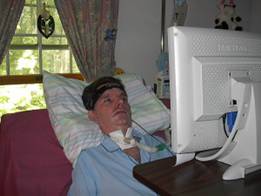 “My
name is Robert. In November of 1996 I was diagnosed with ALS. As I watched my
body melt away, I searched for ways to adapt to my constantly changing body. This
disease doesn't stop at just the arms and legs. It also affects speech, swallowing,
and ultimately breathing. For about a year and a half I was able to use a laser
light fastened to a hat and a letter board. That system worked for a while but
I knew I would need some other kind of communication device but my search didn't
turn up with anything that worked very well or that would satisfy my particular
needs. I was at the end of my rope. I wondered how long I could go on without
being able to communicate. Communication is part of what makes us human. I was
very discouraged.
“My
name is Robert. In November of 1996 I was diagnosed with ALS. As I watched my
body melt away, I searched for ways to adapt to my constantly changing body. This
disease doesn't stop at just the arms and legs. It also affects speech, swallowing,
and ultimately breathing. For about a year and a half I was able to use a laser
light fastened to a hat and a letter board. That system worked for a while but
I knew I would need some other kind of communication device but my search didn't
turn up with anything that worked very well or that would satisfy my particular
needs. I was at the end of my rope. I wondered how long I could go on without
being able to communicate. Communication is part of what makes us human. I was
very discouraged.
Then my nephew discovered Brainfingers. My first thought
was here we go again, another disappointment. I was never so wrong in my life.
With very little practice I found myself moving around my computer screen easily.
I use my eyes to move the cursor left and right and my eyebrows for up and down
movement and my jaw for clicking. The ability to communicate was stolen away from
me by ALS, Brainfingers has given it back to me. When combined with EZ Keys there
isn't anything I can't do on my computer. I can spend however much of my life
I have left, talking with family and friends, which has improved my quality of
life tremendously. My days went from long and meaningless to short and fulfilling.
I urge anyone with impaired motor skills to give it a try.”
Deb Parker writes: “One of our students ("Ronni" not her actual name), 24 years of age, suffered a traumatic brain injury nine years ago. She has spastic quadriplegia, no head control, and no speech and is unable to sit unsupported. Both her upper and lower extremities are severely contracted from the years of spasticity. There is no facial movement. She is unable to even swallow her saliva. She is tube fed. She is just beginning to be able to make guttural noises.
When released from the hospital she remained in a comatose state with response to painful stimulus. Over the years and with numerous interventions she has very slightly improved in responsiveness. She turns her head and eyes in the direction of familiar voices. She moves her thumb upward in response to questions 20 percent of the time. She extends her right lower extremity on command 30 percent of the time. However, she also holds the right lower extremity extended for up to an hour at a time for no apparent reason.
She has been unable to consistently answer questions or interact with family or peers. We continued to feel that there was some type of awareness but could not find a way for her to consistently demonstrate that she did have an increased level of consciousness.
In August of 2001 she received her Brainfingers system with a laptop computer. At that time when connected to Brainfingers only the low frequency theta waves and alpha waves registered any type of movement. When using the slow ball game she was able to connect most often using the theta waves. She was able to move the paddle up and down in pong also using the theta waves.
She worked a half hour five days a week on Brainfingers as a part of her school program. She played slow ball, pong and grow. By December we were seeing sporadic movement in the beta wave graph when she used Brainfingers. During the slow ball game she was able to connect with the white ball occasionally at the beta wave level. While observing her in April it became apparent that the activity at the beta level has now surpassed the alpha level. She is now using brainfinger F9 to control the mouse click and the paddle in pong. The speed of the ball was reduced and she is now able to beat the computer at pong.
There continues to be no facial response from her. Her upper and lower extremities remain rigid and she has no head control. She does vocalize much more, apparently when things are not happening the way she would like. Because of Brainfingers we have a way to test her level of consciousness. She is able to exert control over something. We are hoping she will reach a level of consistency that will allow her to use Brainfingers for simple yes/no communication. Brainfingers has given us something for her to work on in the school setting. Until now the only thing we were able to provide to her was custodial care.”
Deb
Parker PTA
Millet Learning Center
Saginaw, MI 48601